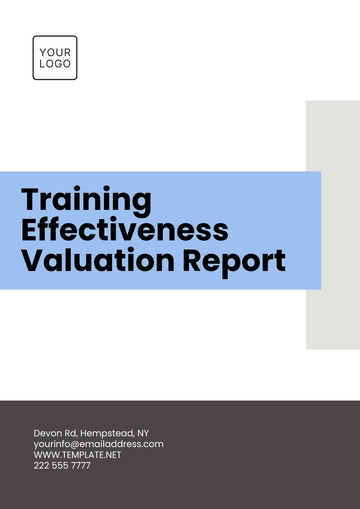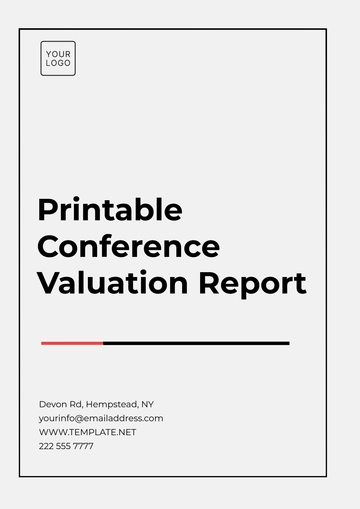Free Business Valuation Report

Title: Business Valuation Report for [Your Company Name]
Prepared by: [Your Name]
Date: [Date]
I. Introduction
A. Purpose
The purpose of this report is to provide a comprehensive valuation of [Your Company Name] for potential investors, stakeholders, and strategic planning.
B. Scope
This report covers the valuation of [Your Company Name] using three different approaches: asset-based, income-based, and market-based.
C. Methodology
Data was collected from financial statements, market reports, and industry benchmarks. Valuation methods included asset-based valuation, discounted cash flow (DCF) analysis, and comparable company analysis.
II. Company Overview
A. Background Information
[Your Company Name] is a leading player in the consumer electronics industry, known for its innovative products and strong market presence. The company has shown consistent growth and profitability over the past five years.
B. Key Financial Metrics
Metric | 2050 | 2051 |
|---|---|---|
Total Revenue | $1.36 billion | $1.5 billion |
Net Profit | $190 million | $200 million |
Total Assets | $1.2 billion | $1.3 billion |
Total Liabilities | $600 million | $650 million |
III. Valuation Methods
The valuation of [Your Company Name] uses three primary methods: asset-based, income-based, and market-based approaches. The asset-based method calculates value by subtracting liabilities from the total value of assets, reflecting the company's intrinsic worth. The income-based approach uses discounted cash flow (DCF) analysis to estimate value based on projected future cash flows, adjusted for risk. The market-based method compares the company with similar industry peers using valuation multiples like P/E and EV/EBITDA ratios. Together, these methods provide a comprehensive estimate of the company’s value.
IV. Valuation Analysis
A. Asset-Based Valuation
The asset-based valuation calculates the net asset value (NAV) by subtracting total liabilities from total assets.
Item | Amount (in billions) |
|---|---|
Total Assets | 1.3 |
Total Liabilities | 0.65 |
Net Asset Value (NAV) | 0.65 |
B. Discounted Cash Flow (DCF) Analysis
The DCF analysis projects future cash flows and discounts them to present value using a discount rate of 8%.
Year | Projected Cash Flow (in millions) | Discount Factor | Present Value (in millions) |
|---|---|---|---|
2050 | 220 | 0.926 | 203 |
2051 | 240 | 0.857 | 205 |
2052 | 260 | 0.794 | 206 |
2053 | 280 | 0.735 | 206 |
2054 | 300 | 0.681 | 204 |
Total | 1,024 |
C. Comparable Company Analysis
The market-based approach involves comparing the company with similar publicly traded companies. Key metrics include the Price-to-Earnings (P/E) ratio and Enterprise Value-to-EBITDA (EV/EBITDA) ratio.
Company | P/E Ratio | EV/EBITDA Ratio |
|---|---|---|
BrandKat | 20 | 12 |
Duofort | 18 | 10 |
[Your Company Name] | 19 | 11 |
V. Conclusion
Based on the analysis, the estimated value of the company is approximately $2.5 billion. This valuation considers the company's strong financial performance, market position, and growth potential.
Valuation Method | Estimated Value (in billions) |
|---|---|
Asset-Based Approach | 0.65 |
Income-Based Approach | 1.02 |
Market-Based Approach | 2.50 |
Overall Valuation | 2.50 |
VI. Recommendations
Consider Strategic Investments: Leverage the company's strong valuation to attract strategic investments for further growth.
Enhance Market Presence: Continue to focus on innovation and market expansion to maintain and increase the company's market value.
Optimize Financial Structure: Review and optimize the company's financial structure to enhance profitability and cash flow.
- 100% Customizable, free editor
- Access 1 Million+ Templates, photo’s & graphics
- Download or share as a template
- Click and replace photos, graphics, text, backgrounds
- Resize, crop, AI write & more
- Access advanced editor
Assess your company's worth accurately with the Business Valuation Report Template by Template.net. This customizable and downloadable template provides a detailed framework for evaluating your business's value. Printable and editable in our AI Editor Tool, it ensures you can adjust the content to suit your specific valuation requirements. Present a clear and professional valuation report to stakeholders and investors.
You may also like
- Sales Report
- Daily Report
- Project Report
- Business Report
- Weekly Report
- Incident Report
- Annual Report
- Report Layout
- Report Design
- Progress Report
- Marketing Report
- Company Report
- Monthly Report
- Audit Report
- Status Report
- School Report
- Reports Hr
- Management Report
- Project Status Report
- Handover Report
- Health And Safety Report
- Restaurant Report
- Construction Report
- Research Report
- Evaluation Report
- Investigation Report
- Employee Report
- Advertising Report
- Weekly Status Report
- Project Management Report
- Finance Report
- Service Report
- Technical Report
- Meeting Report
- Quarterly Report
- Inspection Report
- Medical Report
- Test Report
- Summary Report
- Inventory Report
- Valuation Report
- Operations Report
- Payroll Report
- Training Report
- Job Report
- Case Report
- Performance Report
- Board Report
- Internal Audit Report
- Student Report
- Monthly Management Report
- Small Business Report
- Accident Report
- Call Center Report
- Activity Report
- IT and Software Report
- Internship Report
- Visit Report
- Product Report
- Book Report
- Property Report
- Recruitment Report
- University Report
- Event Report
- SEO Report
- Conference Report
- Narrative Report
- Nursing Home Report
- Preschool Report
- Call Report
- Customer Report
- Employee Incident Report
- Accomplishment Report
- Social Media Report
- Work From Home Report
- Security Report
- Damage Report
- Quality Report
- Internal Report
- Nurse Report
- Real Estate Report
- Hotel Report
- Equipment Report
- Credit Report
- Field Report
- Non Profit Report
- Maintenance Report
- News Report
- Survey Report
- Executive Report
- Law Firm Report
- Advertising Agency Report
- Interior Design Report
- Travel Agency Report
- Stock Report
- Salon Report
- Bug Report
- Workplace Report
- Action Report
- Investor Report
- Cleaning Services Report
- Consulting Report
- Freelancer Report
- Site Visit Report
- Trip Report
- Classroom Observation Report
- Vehicle Report
- Final Report
- Software Report





























